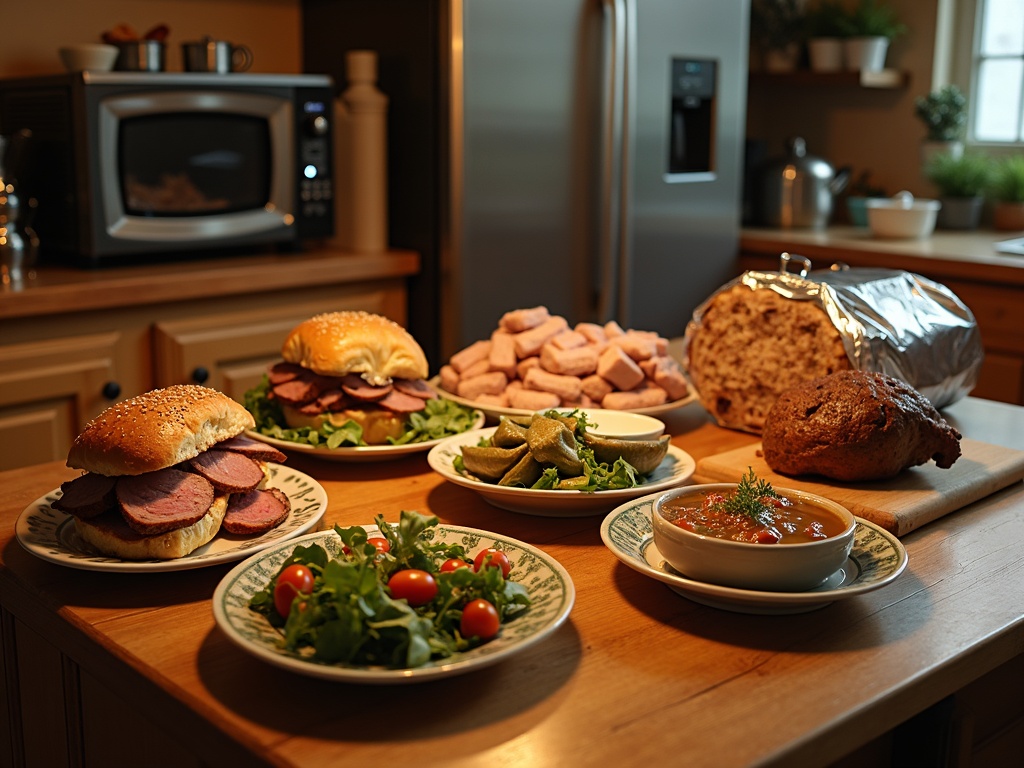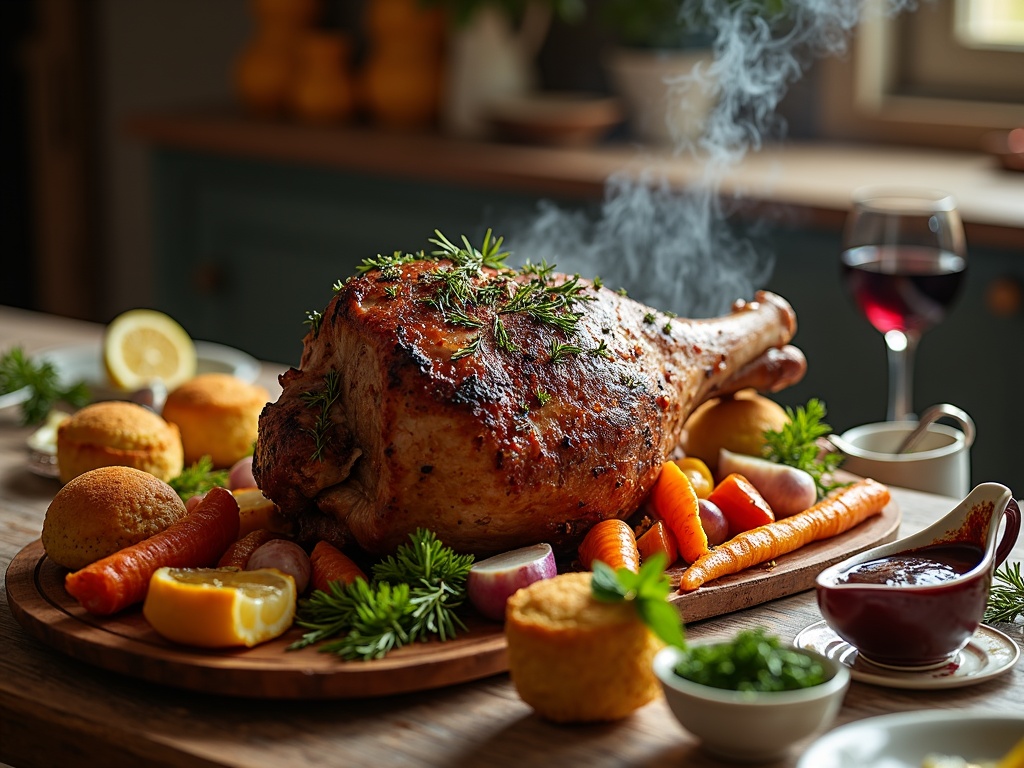Roast lamb stands as the centerpiece of traditional family meals, delivering a perfect balance of rich flavor and melt-in-your-mouth texture when properly prepared. The distinctive taste and self-basting quality of lamb’s fat content make it remarkably flexible, adapting to various cooking methods and flavor profiles from Mediterranean to classic British, while connecting us to culinary traditions spanning generations.
Find In This Article
Key Takeaways
- Quality ingredients are essential for roast lamb, with fresh herbs like rosemary and thyme, garlic, olive oil, and proper seasoning creating the foundation for exceptional flavor.
- Proper preparation includes bringing lamb to room temperature before cooking, patting it dry, making incisions for garlic, and applying a generous herb rub.
- Cooking temperature and time are critical: roast at 375°F (190°C) for about 25 minutes per pound. Use a meat thermometer to reach 135°F (57°C) for medium-rare for best results.
- Resting the lamb for 15–20 minutes after cooking allows juices to redistribute, ensuring moist and flavorful meat when carved.
- Leftover lamb remains delicious for up to three days when refrigerated and can be repurposed into sandwiches, salads, or hearty meals like shepherd’s pie.
What Makes Roast Lamb Special
Roast lamb stands as the cornerstone of traditional Sunday dinners in many households across the UK and beyond. I’ve found this classic dish holds a special place in family gatherings, offering both ceremony and satisfaction that few other meals can match. The aroma that fills the house as lamb roasts slowly in the oven creates an atmosphere of comfort and anticipation that’s hard to replicate with other dishes.
The Perfect Balance of Flavor and Texture
When cooked correctly, lamb delivers a rich, tender eating experience that balances robust flavor with melt-in-your-mouth texture. The secret lies in understanding the meat’s natural characteristics. Unlike other meats, lamb carries a distinctive flavor profile that reflects the animal’s diet and heritage. This natural taste can range from mild to robust depending on factors like the animal’s age and farming practices.
The fat content in lamb plays a crucial role in its appeal. As it renders during cooking, it bastes the meat continuously, resulting in that signature tender texture that good roast lamb is known for. I’ve learned that this self-basting quality makes lamb surprisingly forgiving for home cooks, even those who might feel intimidated by preparing such a centerpiece dish.
What truly sets roast lamb apart is its remarkable versatility. The meat provides a perfect canvas for various flavor profiles and cooking approaches:
- Mediterranean style: Garlic, rosemary, lemon, and olive oil create a fragrant roast that pairs beautifully with tangy tzatziki sauce
- Middle Eastern flair: Warm spices like cumin, coriander, and cinnamon transform the meat into an exotic feast
- Classic British: Simple seasoning lets the meat shine, especially when served alongside traditional Yorkshire puddings
- Greek-inspired: Oregano and lemon bring brightness that works perfectly with dishes like spinach-filled spanakopita
The accompaniments for roast lamb offer endless possibilities too. From mint sauce to redcurrant jelly, the condiment options enhance different aspects of the meat’s flavor. The choice of side dishes can range from the traditional roast potatoes to more adventurous grain-based salads depending on the season and occasion.
I’ve noticed that lamb also accommodates various cooking methods beautifully. While slow roasting remains the classic approach, quicker high-temperature roasting brings extraordinary results for smaller cuts. This adaptability makes lamb suitable for both elaborate weekend feasts and surprisingly achievable weeknight dinners.
The cultural significance of roast lamb can’t be overlooked either. In many traditions, it symbolizes celebration and hospitality. From Easter lunches to special family gatherings, serving roast lamb often signals an occasion worth marking. This cultural weight adds an intangible quality to the experience of both cooking and eating it.
Perhaps most importantly, roast lamb connects us to culinary traditions that span generations. The techniques for preparing it have been passed down through families, creating continuity between the past and present. When I prepare roast lamb using methods I learned from older relatives, I’m participating in a culinary conversation that stretches back centuries.
For anyone who hasn’t made the leap to cooking roast lamb at home, the rewards far outweigh the initial uncertainty. Starting with smaller cuts like a boneless leg or rack makes the process more approachable. The ability to create a meal that feels special without requiring professional culinary skills is part of what makes roast lamb such a cherished centerpiece in so many cooking traditions.
Essential Ingredients for Success
The foundation of a memorable roast lamb lies in selecting quality ingredients that complement the meat’s natural flavors. I’ve found that focusing on fresh, simple components makes all the difference between an ordinary meal and an outstanding dining experience.
The Star of the Show: Lamb
Starting with a 4-5 pound leg of lamb gives you the perfect size for a family dinner or small gathering. This cut offers a beautiful balance of meat and fat, ensuring juicy results. When shopping, look for meat with a bright pink color and white, firm fat—signs of freshness and quality.
Fresh herbs play a crucial role in elevating lamb’s flavor profile. Rosemary and thyme are classic companions that infuse the meat with aromatic qualities during roasting. Their woody, earthy notes create depth that perfectly balances lamb’s distinctive taste.
Garlic cloves add essential pungency that mellows beautifully when roasted. I’ve discovered that slicing garlic into slivers and inserting them directly into small cuts in the meat allows their flavor to penetrate deeply.
Quality olive oil serves multiple purposes—it helps herbs and spices adhere to the meat while promoting beautiful browning. A generous coating creates that coveted crisp exterior while keeping the interior moist.
Proper seasoning is non-negotiable. Sea salt and freshly cracked black pepper enhance all other flavors while bringing out lamb’s natural taste. Don’t be shy—lamb can handle robust seasoning.
Supporting Cast: Liquids and Vegetables
Adding white wine to the roasting pan creates a flavorful steam environment that keeps the meat moist while developing into a base for spectacular gravy. I’ve found that about one cup is sufficient for a standard roast.
The traditional accompaniments—root vegetables—shouldn’t be overlooked. Consider these options for roasting alongside your lamb:
- Potatoes: Cut into chunks to absorb the meat’s flavorful drippings
- Carrots: Their natural sweetness intensifies with roasting
- Parsnips: Offer a nutty counterpoint to lamb’s richness
- Onions: Transform into caramelized delights during cooking
- Turnips: Add subtle peppery notes to the vegetable medley
These vegetables not only complete the meal but also capture the lamb’s juices, making them incredibly flavorful. For a complete British dining experience, consider serving your roast lamb with traditional Yorkshire puddings on the side.
With these quality ingredients prepared thoughtfully, you’re well on your way to creating a roast lamb dinner that will impress even the most discerning guests.
Preparing Your Lamb
The secret to a perfect roast lamb starts long before it hits the oven. I’ve found that proper preparation sets the foundation for that mouth-watering, tender result we all crave.
Essential Preparation Steps
First things first – I always take the lamb out of the refrigerator about 1 hour before cooking. This crucial step allows the meat to reach room temperature, ensuring more even cooking throughout. Cold meat straight from the fridge will cook unevenly, often leaving you with an overcooked exterior and undercooked center.
Once my lamb has warmed up a bit, I pat it completely dry with paper towels. This might seem like a small detail, but removing surface moisture is key to achieving that beautiful golden-brown crust that makes traditional meat dishes so appealing.
For maximum flavor infusion, I make small incisions all over the lamb using a sharp knife. These little pockets are perfect for inserting slivers of garlic that will melt into the meat as it cooks, creating pockets of incredible flavor throughout the roast.
Next comes the seasoning stage. I generously rub the lamb with a mixture of fresh herbs and seasonings. My go-to combination includes:
- Rosemary and thyme (fresh works best)
- Sea salt and freshly cracked black pepper
- Olive oil to help everything stick
- Lemon zest for brightness
- Minced garlic for extra flavor
The final preparation step involves the roasting pan setup. I place roughly chopped vegetables around the lamb to create a flavorful foundation. Onions, carrots, and celery work perfectly here – they’ll caramelize during cooking and can be served alongside the lamb or used to make an excellent rich gravy later.
For a Mediterranean twist, adding lemon wedges and olives around your lamb creates a delicious variation similar to what you might find in a Greek-inspired meal. The citrus adds brightness while protecting the meat from drying out.
By following these preparation steps, I’ve consistently created lamb roasts that impress even the most critical dinner guests. The attention to detail during this phase pays huge dividends in the final flavor and texture of your finished dish.
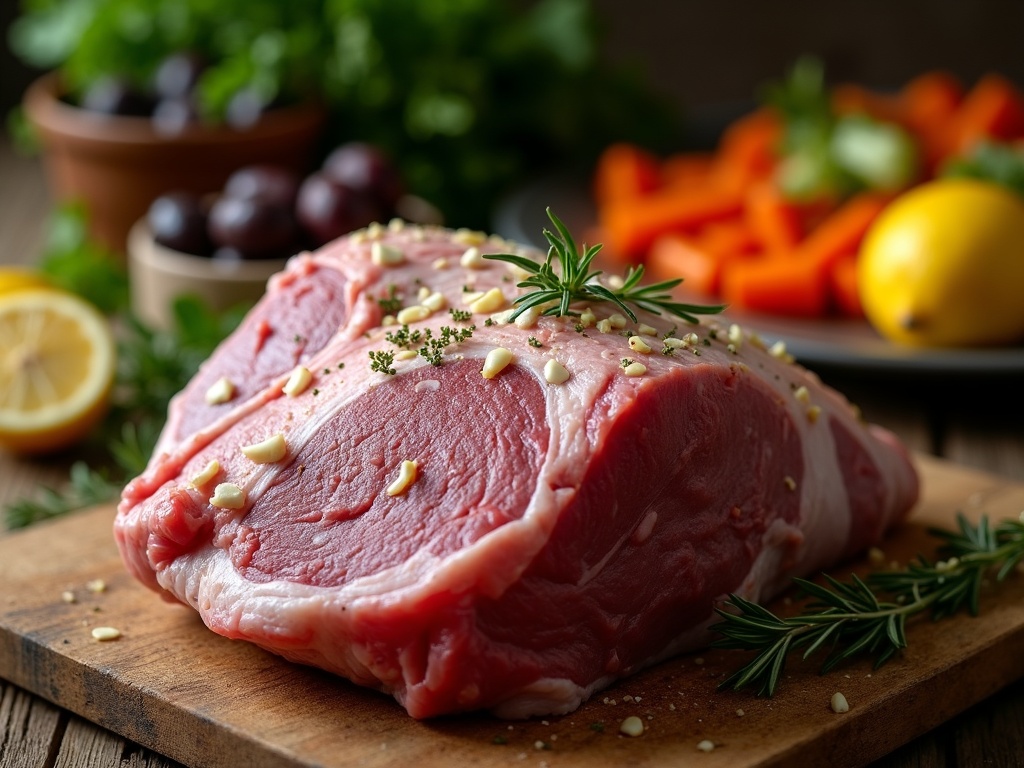
Temperature and Timing Guide
Getting the temperature and timing right when cooking roast lamb is crucial for achieving that perfect blend of tenderness, flavor, and juiciness. I’ve found that precision in this step makes all the difference between a mediocre meal and a memorable feast.
Before anything else, I always preheat my oven to 375°F (190°C). This moderate temperature is ideal for roast lamb as it allows the meat to cook evenly without drying out or burning the exterior. Preheating is essential—placing lamb in a cold oven will throw off your timing calculations and potentially lead to uneven cooking.
When calculating cooking time, I follow the reliable standard of 25 minutes per pound for medium-rare results. For example, a 4-pound leg of lamb will need approximately 1 hour and 40 minutes in the oven. This formula creates that perfect pink center while ensuring the meat is safely cooked. If you prefer your lamb more done, you can add 5–10 minutes per pound, but I’ve found that medium-rare showcases lamb’s natural flavors best.
Monitoring Internal Temperature
The most accurate way to determine when lamb is perfectly cooked is by using a meat thermometer. For medium-rare lamb, I aim for an internal temperature of 135°F (57°C). This is the sweet spot where the meat will be:
- Pink and juicy in the center
- Safe to eat
- Tender with optimal flavor
- Not overly bloody or raw
I avoid relying solely on cooking time since oven performance varies significantly. A meat thermometer inserted into the thickest part of the lamb (without touching bone) gives me the confidence to know exactly when to remove it from the oven.
Once the lamb reaches the target temperature, I immediately remove it from the oven. Here comes another crucial step that many cooks overlook—resting the meat for 15–20 minutes before carving. This resting period allows the juices to redistribute throughout the meat. If you carve too soon, those flavorful juices will run onto your cutting board instead of remaining in each slice.
During the resting period, the lamb’s internal temperature continues to rise slightly (about 5–10 degrees) through carryover cooking, so I take this into account when deciding when to remove it from the oven. I loosely tent the roast with foil during this time to keep it warm without trapping steam that would soften the crispy exterior.
The timing for a perfectly roasted lamb pairs beautifully with traditional sides like classic Yorkshire pudding, which can be baked while the meat rests. The resting period also provides the perfect opportunity to finish preparing any accompanying dishes like a mint sauce or cooling tzatziki that complements the rich flavors of the lamb.
For larger cuts or bone-in roasts, I add a bit more resting time – up to 30 minutes for a whole leg. This patience pays off in the final result, delivering slices that retain their moisture and flavor. The dinner table conversations will pause momentarily as everyone savors that first perfect bite – the hallmark of a well-executed roast lamb.
Common Mistakes to Avoid
Perfecting a roast lamb dish takes practice, and I’ve seen many home cooks struggle with the same issues. Understanding these common pitfalls can transform your lamb from ordinary to extraordinary.
Critical Errors That Ruin Your Roast
Cooking straight from the refrigerator is a mistake I made repeatedly when first attempting roast lamb. Cold meat cooks unevenly, with the exterior potentially burning while the center remains raw. Instead, I always allow my lamb to sit at room temperature for at least 30-45 minutes before roasting. This simple step helps achieve that perfect pink center while maintaining a beautiful crust.
Not letting meat rest after cooking robs you of flavor and texture. The resting period allows juices to redistribute through the meat. I’ve found that a good rule is to rest the lamb for about 15-20 minutes, loosely tented with foil. This patience rewards you with more flavorful and juicy meat, much like when preparing a traditional Irish stew with lamb.
Overcooking the meat is perhaps the most common mistake. Lamb shines when cooked to medium-rare or medium — around 130-135°F for medium-rare and 135-140°F for medium. I always use a meat thermometer rather than guessing, as appearances can be deceiving.
Skipping the seasoning process means missing an opportunity to enhance flavor. Beyond salt and pepper, lamb pairs beautifully with:
- Fresh herbs like rosemary, thyme, and mint
- Garlic and lemon zest for brightness
- Spices such as cumin or coriander for depth
Incorrect oven temperature can derail your efforts quickly. I start with a high temperature (around 450°F) to develop a crust, then reduce to 325-350°F to finish cooking. This method gives you that perfect contrast between exterior and interior, similar to techniques used for cottage pie where contrast between layers creates magic.
Neglecting to trim excess fat is another pitfall – while some fat adds flavor, too much can make your dish greasy. I trim larger fat deposits while leaving a thin layer to baste the meat naturally during cooking.
Finally, carving against the grain makes a significant difference in tenderness. I always identify the direction of the meat fibers and cut perpendicular to them for the most tender bite experience.
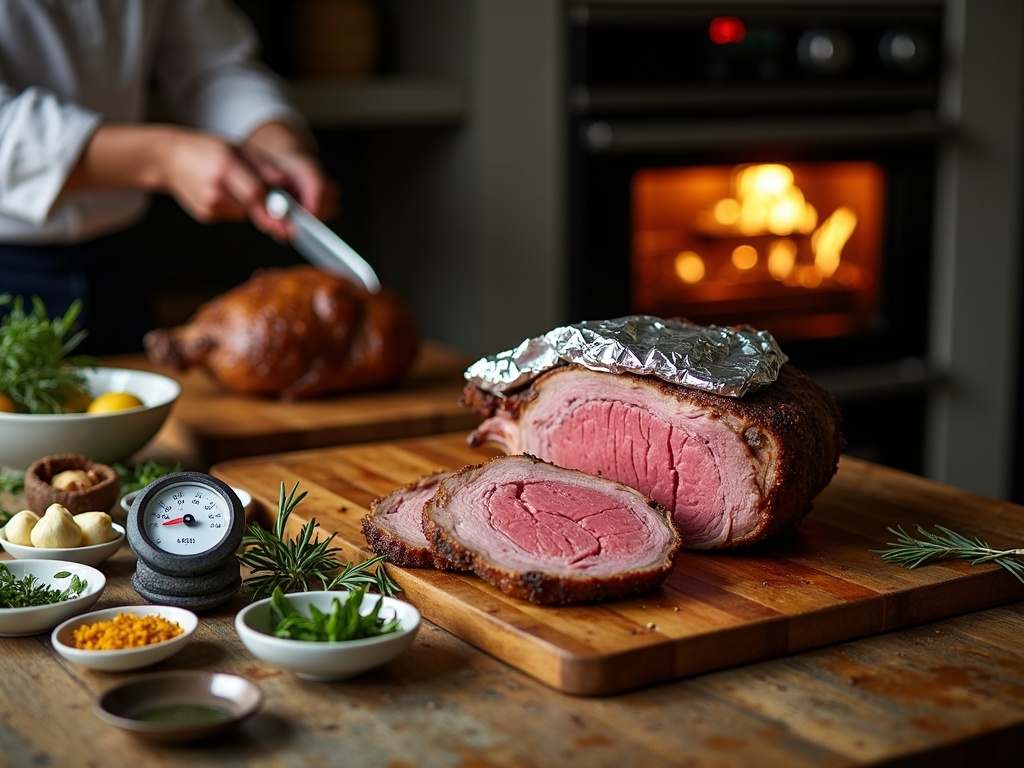
Expert Tips for Perfect Results
Getting that perfect roast lamb isn’t just about the recipe—it’s about technique. I’ve gathered some essential tips that will elevate your lamb from good to spectacular, ensuring juicy, flavorful results every time.
Mastering the Art of Roasting
A meat thermometer is your best friend when cooking lamb. For medium-rare, aim for an internal temperature of 135°F (57°C), while medium should register around 145°F (63°C). The thermometer takes the guesswork out of cooking, helping you avoid the disappointment of overcooked, dry meat.
Basting makes a huge difference in keeping your lamb moist and flavorful. Every 30 minutes, spoon the pan juices over the meat to maintain juiciness and build a beautiful crust. This simple step creates a self-marinating effect throughout the cooking process.
Always position your lamb fat side up in the roasting pan. This allows the fat to melt and naturally baste the meat as it cooks, creating a self-basting effect that keeps everything moist and adds depth of flavor.
Creating a herb crust isn’t just for show—it’s a flavor powerhouse. I like to mix fresh herbs like rosemary, thyme, and mint with garlic, olive oil, and lemon zest. Press this mixture onto the lamb before roasting for an aromatic crust that infuses the meat with gorgeous flavors. For additional Mediterranean flavors, consider pairing your lamb with a classic homemade tzatziki sauce for a refreshing contrast.
Don’t waste those precious pan juices! After removing the roast, transfer the juices to a saucepan, skim excess fat, and simmer with a splash of red wine and stock to create a rich gravy. This step captures all the concentrated flavors from the roasting process.
For a complete Sunday dinner experience, serve your perfectly roasted lamb with crispy Yorkshire puddings for a traditional pairing that soaks up all that delicious gravy.
These techniques work whether you’re cooking a leg, shoulder, or rack of lamb. The principles remain the same, though cooking times will vary based on the cut and weight of your meat.
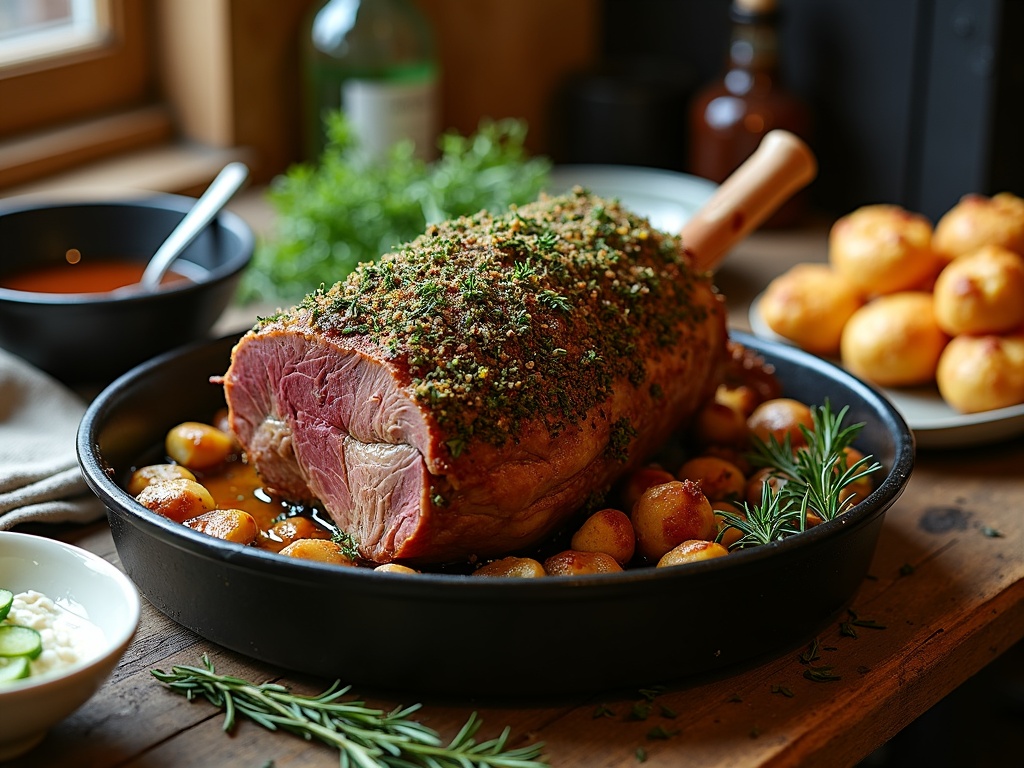
Serving Suggestions
A perfectly roasted lamb deserves accompaniments that complement its rich, succulent flavor. I’ve found that the right side dishes can transform this classic meal into a memorable feast for family and friends. Here are some tried and tested serving suggestions that pair beautifully with roast lamb.
Classic Accompaniments
Traditional mint sauce is an absolute must when serving roast lamb. The bright, fresh flavor cuts through the richness of the meat, creating a perfect balance. I make mine by finely chopping fresh mint leaves and mixing them with a little sugar, boiling water, and white wine vinegar. The sauce should steep for at least 30 minutes before serving to allow the flavors to develop.
Roast lamb also pairs wonderfully with traditional Yorkshire puddings that rise beautifully in the oven. These light and crispy delights are perfect for soaking up the flavorful meat juices and gravy. The contrast between their crunchy exterior and soft inside adds a delightful texture to your meal.
No roast dinner is complete without a rich red wine gravy. I make mine using the meat drippings, a splash of good quality red wine, stock, and a touch of redcurrant jelly for sweetness. The depth of flavor complements the lamb without overpowering it, and the silky texture brings everything together on the plate.
Vegetable Pairings
Roasted root vegetables make an excellent side dish for lamb. I love to roast carrots, parsnips, and red onions with a drizzle of honey, some fresh thyme, and a good glug of olive oil. The caramelization that happens in the oven brings out their natural sweetness, which pairs perfectly with the savory notes of the lamb.
Fresh seasonal vegetables add color, texture, and nutritional balance to your roast lamb meal. In spring, tender asparagus spears or garden peas make excellent choices. Summer calls for fresh green beans or corn on the cob. Fall and winter roast lamb dinners benefit from:
- Brussels sprouts roasted with bacon bits and a balsamic glaze
- Braised red cabbage with a hint of apple and cinnamon
- Steamed broccoli dressed with lemon zest and toasted almonds
- Cooling tzatziki for a Mediterranean twist
- Buttered spinach with a hint of nutmeg
For a heartier option, especially during colder months, consider serving Irish stew sides like colcannon or champ alongside your roast lamb. These potato-based dishes provide comforting substance that complements the meat beautifully.
If you’re looking for a Mediterranean influence, roasted lamb can be served with couscous or bulgur wheat flavored with lemon, herbs, and chopped fresh vegetables. This lighter alternative works particularly well with leg of lamb that’s been marinated with garlic and herbs.
For entertaining, I sometimes create a more substantial spread by adding a savory side dish like scalloped potatoes layered with cream and cheese. The richness pairs wonderfully with the lamb’s flavor profile.
Remember that roast lamb is versatile enough to work with both traditional British sides and more exotic Mediterranean or Middle Eastern accompaniments. The key is balancing flavors and textures to create a harmonious meal that showcases this magnificent meat at its best.
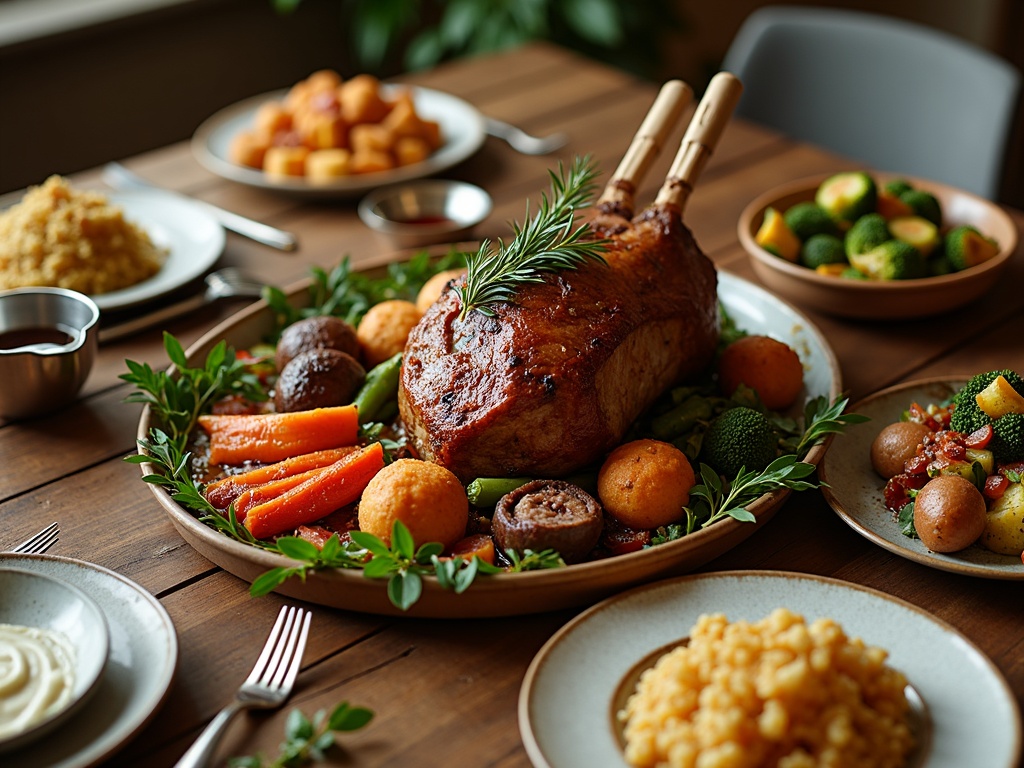
Storage and Leftovers
After enjoying a delicious roast lamb meal, you might find yourself with leftovers that are too good to waste. I’ve discovered that proper storage not only preserves the meat’s flavor but also gives you the opportunity to create entirely new dishes from your initial effort.
Refrigerated roast lamb maintains its quality for up to 3 days when stored properly. To ensure the best results, I recommend letting the meat cool completely before transferring it to an airtight container. This prevents condensation that can make the meat soggy and accelerate spoilage. Slicing the lamb before storing can save time later, but keeping it whole typically helps it retain moisture longer.
The beauty of leftover roast lamb is its versatility. I’ve found countless ways to transform yesterday’s dinner into today’s culinary delight. The rich, distinctive flavor of lamb works wonderfully in quick meals that require minimal preparation.
Creative Uses for Leftover Lamb
For lunch options that make coworkers envious, consider these ideas:
- Layer thin slices of cold lamb with mint jelly or tzatziki sauce on crusty bread for a flavorful tzatziki sandwich that brings Mediterranean flair to your lunch
- Dice and toss with mixed greens, feta cheese, and a light vinaigrette for a protein-packed salad
- Chop and add to warmed leftover gravy, then serve over mashed potatoes for a quick twist on a cottage pie dinner
- Shred and combine with herbs, then fold into fluffy Yorkshire puddings for a British-inspired treat
- Mix with rice, herbs and spices for stuffed peppers or grape leaves
If you won’t use your leftover lamb within three days, freezing is an excellent option. I’ve had great success with portioning the meat before freezing, which allows me to thaw only what I need for future meals. Wrapped tightly in freezer paper and placed in airtight containers or freezer bags, roast lamb freezes beautifully for up to three months. Labeling packages with the date ensures you use the oldest portions first.
When reheating lamb, thorough heating is essential for food safety, but care must be taken to prevent the meat from drying out. For sliced lamb, a quick bath in warm gravy or broth before serving restores moisture and enhances flavor. If reheating a larger portion, I cover it loosely with foil in a 300°F oven until it reaches 165°F internally.
The microwave works in a pinch, but use a lower power setting and check frequently. Adding a tablespoon of liquid and covering the dish helps the meat steam gently rather than toughen. For frozen lamb, I recommend thawing completely in the refrigerator before reheating for more even results.
One of my favorite approaches for leftover roast lamb is to reimagine it entirely. Chopped lamb adds richness to a traditional Irish stew, bringing depth to the broth without requiring hours of cooking time. The strong flavor of lamb also pairs beautifully with spinach in a filling for savory pastries, similar to a meat-focused spanakopita.
Game meat enthusiasts might note that the same storage principles apply to other roasted meats like venison recipes, making these tips useful for various special occasion leftovers.
With proper storage and creative repurposing, your roast lamb investment pays culinary dividends for days beyond the initial meal, making it a smart choice for both special occasions and weekly meal planning.
